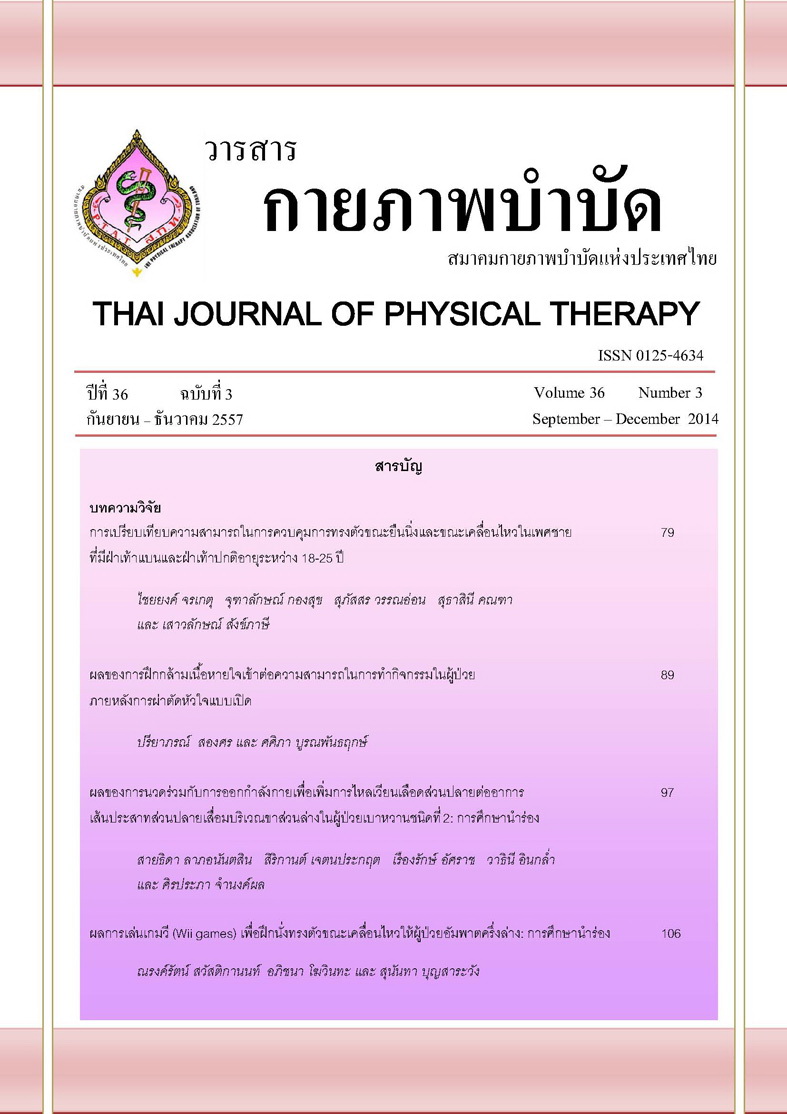การเปรียบเทียบความสามารถในการควบคุมการทรงตัวขณะยืนนิ่งและขณะเคลื่อนไหวในเพศชาย ที่มีฝ่าเท้าแบนและฝ่าเท้าปกติอายุระหว่าง 18-25 ปี
Main Article Content
บทคัดย่อ
ความล้มเหลวของโครงสร้างของเท้าในผู้ที่มีฝ่าเท้าแบนอาจเป็นสาเหตุที่ทำให้เกิดความไม่มั่นคงของข้อเท้าได้ วัตถุประสงค์ เพื่อเปรียบเทียบความแตกต่างของการควบคุมความมั่นคงของข้อเท้าขณะอยู่นิ่งและเคลื่อนไหวระหว่างผู้ที่มีฝ่าเท้าแบนและฝ่าเท้าปกติวิธีการวิจัย อาสาสมัครชายสุขภาพดีที่มีฝ่าเท้าแบน (15 คน) และฝ่าเท้าปกติ (15 คน) ทดสอบการทรงตัวขณะอยู่นิ่งด้วย One leg standing (OLS) และขณะเคลื่อนไหวด้วย Functional reach test (FRT) และ Multiple directional reach test (MRT) ใช้สถิติ Independent-t-test และ Mann Whitney U test ทดสอบความแตกต่างของตัวแปรที่ใช้ในการศึกษาระหว่างกลุ่ม ผลการวิจัย ระหว่างกลุ่มที่มีฝ่าเท้าแบนและฝ่าเท้าปกติไม่พบความแตกต่างของค่าเฉลี่ยจากการทดสอบ OLS (ขณะลืมตา: 14.84±9.48 วินาที และ 20.01±9.86 วินาที, ขณะหลับตา: 3.06±1.87 วินาที และ 3.82±2.18 วินาที) การทดสอบ FRT (10.13±3.25 นิ้ว และ 11.91±1.98 นิ้ว) และการทดสอบ MRT ด้านซ้าย (6.71±2.02 นิ้ว และ 7.49±1.11 นิ้ว) แต่พบความแตกต่างอย่างมีนัยสำคัญทางสถิติในการทดสอบMRT ด้านขวา (6.62±1.74 นิ้ว และ 8.10±1.43 นิ้ว, p<0.05) สรุป การควบคุมความมั่นคงของข้อเท้าขณะอยู่นิ่งระหว่างผู้ที่มีฝ่าเท้าปกติและฝ่าเท้าแบนไม่มีความแตกต่างกัน ความแตกต่างของการควบคุมความมั่นคงของข้อเท้าขณะเคลื่อนไหวที่พบอาจไม่มีนัยสำคัญในทางคลินิก
Article Details
เอกสารอ้างอิง
2. Gutierrez GM, Kaminski TW, Douex AT. Neuromuscular Control and Ankle Instability. PM R 2009; 1(4): 359-65.
3. Hertel J. Functional Anatomy, pathomechanics, and pathophysiology of lateral ankle instability. J Athl Train 2002; 37(4): 364-75.
4. Riemann BL, Lephart SM.Sensorimotor system, part II: the role of proprioception in motor control and functional joint stability. J Athl Train 2002; 37(1): 80-4.
5. Pijnenburg AC, Van Dijk CN, Bossuyt PM, Marti RK. Treatment of ruptures of the lateral ankle ligaments: a meta-analysis. J Bone Joint Surg Am 2000; 82(6): 761-73.
6. Jonsson E, Seiger A, Hirschfeld H. One-leg stance in healthy young and elderly adults: a measure of postural steadiness? Clin Biomech (Bristol, Avon) 2004; 19(7): 688-94.
7. Hunt AE, Smith RM. Mechanics and control of the flat versus normal foot during the stance phase of walking. Clin Biomech 2004; 19: 391-7.
8. Fan Y, Fan Y, Li Z, Lv C, Luo D. Natural gaits of the non-pathological flat foot and high-arched foot. PLoS ONE 2011; 6(3); e17749.
9. Chang H-W, Chieh H-F, Lin-C-J, Su FC, Tsai M-J. The relationship between foot arch volumes and dynamic plantar pressure during midstance of walking in preschool children. PLoS ONE 2014; 9(4): e94535.
10. Barry RJ, Scranton PE Jr. Flat feet in children. Clin Orthop Relat Res 1983; (181):68-75.
11. Rao UB, Joseph B. The influence of footwear on the prevalence of flat foot: a survey of 2,300 children. J Bone Joint Surg Br 1992; 74: 525-7.
12. สุจิตรา บุญหยง. ผลของการเสริมอุ้งเท้าด้านในต่อรูปแบบการกระจายของแรงใต้ฝ่าเท้าในเท้าแบนที่ปรับตัวได้และไม่มีอาการ [วิทยานิพนธ์ / วิทยาศาสตรมหาบัณฑิต (กายภาพบำบัด)]. กรุงเทพมหานคร: บัณฑิตวิทยาลัยมหาวิทยาลัยมหิดล;1998.
13. Hertel J, Gay MR, Denegar CR. Differences in postural control during single-leg stance among healthy individuals with different foot types. J Athl Train 2002; 37: 129-32.
14. Cote KP, Brunet ME, Gansneder BM, Shultz SJ. Effects of pronated and supinated foot postures on static and dynamic postural stability. J Athl Train 2005; 40: 41-6.
15. Lin CW, Hiller CE, de Bie RA. Evidence-based treatment for ankle injuries: a clinical perspective. J Man Manip Ther 2010; 18: 22-8.
16. Murley GS MH, Landorf KB. A protocal for classifying normal and flat-arched foot posture for research studies using clinical and radiographic measurements. J Foot Ankle Res 2009; 2: 22.
17. Springer BA, Marin R, Cyhan T, Roberts H, Gill NW. Normative values for the unipedal stance test with eyes open and closed. J Geriatr Phys Ther 2007; 30: 8-15.
18. Duncan PW, Weiner DK, Chandler J, Studenski S. Functional reach: a new clinical measure of balance. J Gerontol 1990; 45: M192-7.
19. Newton RA. Validity of the multi-directional reach test: a practical measure for limits of stability in older adults. J Gerontol A Biol Sci Med Sci 2001; 56: M248-52.
20. Robert A, Donatelli. The Biomechanics of the foot and ankle. Philadelphia: FA Davis Company. 1996: 91-5, 104-5, 180-1.
21. Camicioli R,Moore MM, Sexton G,Howieson DB,Kaye JA. Age-related brain changes associated with motor function in healthy older people. J Am Geriatr Soc 1999; 47 (3): 330-4.
22. Hertel J. Sensorimotor deficits with ankle sprains and chronic ankle instability. Clin Sports Med 2008; 27: 353-70.


